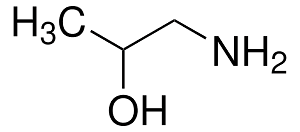Monoisopropanolamine

Product Description
Monoisopropanolamine (MIPA) is a versatile chemical compound with numerous industrial applications.
Product:
Monoisopropanolamine
CAS:
78-96-6
Synonym:
1-Amino-2-propanol
Structure:

Typical Characteristics
Appearance
Colorless liquid
Boiling point
160 °C
Density
0.96 g/cm3
Flash Point
77 °C
Melting point
−2 °C
Molecular Weight
75.11
Odor
Slight ammonia-like odor
Purity
93%
Refractive index
1.4478
Uses, Applications & Markets
Key applications
get a quote
We Offer Monoisopropanolamine
in various grades
A few of the grades available are listed below:



Monoisopropanolamine used in many
industry applications
Monoisopropanolamine (MIPA) is a versatile chemical compound with numerous industrial applications. Some of its key uses include:
- Surfactants: MIPA is commonly employed in the production of surfactants used in detergents, cosmetics, and personal care products. It serves as a key ingredient in formulations designed to reduce surface tension, enhance wetting and dispersing properties, and improve emulsification.
- Corrosion Inhibitors: Due to its ability to form protective films on metal surfaces, MIPA is utilized as a corrosion inhibitor in various industrial processes, such as metalworking fluids, cooling water systems, and oilfield applications. It helps prevent metal degradation and extend the service life of equipment and infrastructure.
- Gas Treating Agents: MIPA is employed in the gas processing industry as an absorbent for removing acidic gases, such as carbon dioxide (CO2) and hydrogen sulfide (H2S), from natural gas streams. It reacts with acidic components to form stable salts or complexes, thereby purifying the gas and meeting pipeline specifications.
- Concrete Additives: In the construction sector, MIPA is used as a cement grinding aid to improve the efficiency of the grinding process and enhance the performance of cementitious materials. It facilitates particle size reduction, increases mill throughput, and improves cement flowability and strength development.
- Personal Care Products: MIPA finds applications in the formulation of personal care products, including shampoos, conditioners, and skin cleansers. It acts as a pH adjuster, buffering agent, or emulsifying agent, contributing to product stability, texture, and sensory attributes.
- Chemical Intermediates: MIPA serves as a precursor or intermediate in the synthesis of various organic compounds, such as pharmaceuticals, agrochemicals, and specialty chemicals. It undergoes reactions with other chemicals to form derivatives with specific properties and functionalities.
- Textile Auxiliaries: In the textile industry, MIPA is used as a dye levelling agent or dyeing assistant to improve the uniformity and consistency of coloration on textile fibers. It helps prevent uneven dye uptake and ensures uniform dye distribution, resulting in high-quality dyed fabrics.
- Adhesives and Sealants: MIPA may be included in adhesive and sealant formulations to enhance adhesion, cohesion, and moisture resistance. It serves as a curing agent or crosslinking agent in polyurethane-based adhesives, providing strong and durable bonds in various applications.